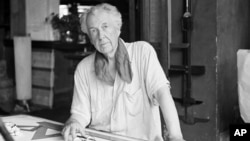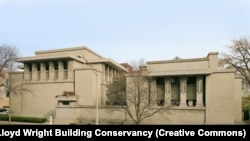The United States has nominated 10 buildings designed by American architect Frank Lloyd Wright for inclusion on the World Heritage List of the U.N. Educational, Scientific and Cultural Organization.
"Through its World Heritage Sites the United States can share with the world the remarkable diversity of our cultural heritage as well as the beauty of our land,” U.S. Interior Secretary Sally Jewell said in announcing the nomination.
UNESCO's World Heritage List recognizes the “outstanding universal value” of the most significant cultural and natural sites worldwide.
The proposal to UNESCO, “Key Works of Modern Architecture by Frank Lloyd Wright,” includes reproductions of Wright's original sketches and drawings for the 10 buildings, along with photographs of the designs as they were completed.
The nominated Wright works are Unity Temple in Oak Park, Illinois; Frederick C. Robie House in Chicago; Taliesin in Spring Green, Wisconsin; Hollyhock House in Los Angeles; Fallingwater in Mill Run, Pennsylvania; Herbert and Katherine Jacobs House in Madison, Wisconsin; Taliesin West in Scottsdale, Arizona; the Solomon R. Guggenheim Museum in New York City; Price Tower in Bartlesville, Oklahoma; and the Marin County Civic Center in San Rafael, California.
All of the properties, built between 1906 and 1969, already are designated as U.S. National Historic Landmarks.
“Wright was the father of modern architecture, fundamentally redefining the nature of form and space during the early 20th century in ways that would have enduring impact on modern architecture worldwide,” said Richard Longstreth, president of the Frank Lloyd Wright Building Conservancy, which appointed a committee of experts in 2003 to choose the buildings, in consultation with the National Park Service.
“We had to demonstrate how each represents a masterpiece of human creative genius and is an extraordinary contribution to modern architecture and culture,” said Lynda Waggoner, director of Wright’s internationally acclaimed Fallingwater.
The nomination will be considered for inscription on the World Heritage List by the UNESCO World Heritage Committee, with a decision due by mid-2016. If approved, these would be the first World Heritage listings for U.S. modern architecture. The World Heritage List already includes 22 other American sites of natural, cultural or archeological significance — among them the Grand Canyon, Yellowstone National Park and the Statue of Liberty.
UNESCO has bestowed World Heritage designations on more than 1,000 sites in more than 160 countries worldwide, from the Taj Mahal to Australia's Great Barrier Reef to Stonehenge in England.
Nominated Buildings:
These brief descriptions of the nominated buildings rely on information supplied by the Frank Lloyd Wright Building Conservancy:
Unity Temple (1905, Oak Park, Illinois)
Unity Temple is Wright’s only surviving public building from his Prairie period. Limited by a modest budget and an urban site, Wright created a bold design and used unconventional materials to produce a groundbreaking building. Constructed of exposed, poured-in-place reinforced concrete, Unity Temple was one of the earliest uses of the low-cost, revolutionary new material in a public, nonindustrial building. While the unpainted concrete exterior is presented as a solid cubic mass, the interior is its opposite: Spaces are floating, colored planes held together by lighting from above. Today, its auditorium/worship space is still used for religious services, performances and assemblies.
Frederick C. Robie House (1908, Chicago)
The Robie House is the most famous and most influential of Wright’s Prairie houses. Its brilliance lies in the use of horizontal lines to dramatically reflect the prairie landscape of the U.S. Midwest. At the time of its creation, the dynamic and open flow of space forming the living and dining rooms was a radical conception of modern living space. Equally significant is the dissolution of more traditional solid walls into intersecting and floating planes that define, rather than contain, interior space. In the ’40s and ’50s the house was threatened with demolition. Today it is owned by the University of Chicago and is operated as a museum by the Frank Lloyd Wright Trust.
Taliesin (begun 1911, Spring Green, Wisconsin)
Wright designed Taliesin as a home and studio for himself. Rebuilt and expanded after two major fires, it grew and evolved over half a century under Wright’s direction. Most of the rooms are entered at a corner, resulting in dynamic diagonal sight lines that emphasize the interior space and extend the view through horizontal bands of windows beyond the house and out to the landscape. The careful, sensitive site planning and the use of many native materials reinforce Taliesin’s integration of building and landscape, making it a supreme expression of U.S. domestic architecture in its openness to nature. The Taliesin estate remains in the ownership of the Frank Lloyd Wright Foundation and has continued to be used by the Taliesin Fellowship and the Frank Lloyd Wright School of Architecture as a summer residence and campus. Taliesin Preservation Inc. conducts public tours of the estate from April to November.
Hollyhock House (1918, Los Angeles)
Wright’s first Southern California commission, Hollyhock House works with a vocabulary of forms referring broadly to the histories of Spanish California and pre-Columbian Mexico. Wright's unique expression of Southern California reflected regionalism in a truly modern form — through sculpture and other decorative art forms, including an abstraction of a hollyhock flower. All spaces open into a central patio, making it “half house and half garden,” with multilevel rooftop terraces encircling the patio court, linked by bridges and stairways. Client Aline Barnsdall wanted Wright to create an arts complex that would include a theater for the production of avant-garde plays, a cinema, studios for artists, housing for actors and directors, and a personal residence. Today Hollyhock House is open for tours as a house museum and also contains exhibition space.
Fallingwater (1935, Mill Run, Pennsylvania)
Fallingwater is among the world’s best-known private residences. An astonishing construction and a consummate example of the union of architecture and nature, the house was designed as a series of three horizontal "trays" — floors stacked one upon the other — that appear to soar with no support outward over a 10-meter waterfall below. Fallingwater masterfully integrates reinforced concrete, steel and glass along with natural materials — wood and native stone. The building's unique and daring cantilevered construction stretched the limits of design and technology of the period. Fallingwater is also an astonishing expression of its physical site: The house cascades down a hillside like the water over the rocks below. Today the house is a museum operated by the Western Pennsylvania Conservancy.
Herbert and Katherine Jacobs House (1936, Madison, Wisconsin)
Ranked by the American Institute of Architects as one of the 20 most important residential designs of the 20th century, the Jacobs House was designed and built for a family of ordinary means, a response to the evolving economic and social conditions of the country during the Great Depression and the era of expanding suburbs in the United States. It uses the most basic geometric forms and materials to create economical, small spaces and elegant but minimalist design. The efficient spatial design is warmed by reliable, simple materials — brick and gleaming wood. In the living room a comparatively high ceiling and series of full-height glazed doors open onto a terrace and garden, creating a continuous in-and-out flow and offering a sense of spaciousness rarely found in houses of its size. The house is privately owned and maintained as a private residence; it is open by appointment for public tours.
Taliesin West (begun 1938, Scottsdale, Arizona)
The building of Taliesin West, Wright’s winter home and studio, occupied the last 20 years of his life. In the numerous structures of Taliesin West, the architect explored new construction techniques and design concepts and experimented with new materials — all specific to the desert context — which he later used in designs for clients. Primitive “desert rubble stone” masonry is created from small boulders and stones found at the site and consolidated with concrete, creating a mosaic-like surface for the masonry walls. The ensemble of structures can be likened to a vast outdoor home whose strong angular shapes echo the landscape. Taliesin West continues to house the offices of the Frank Lloyd Wright Foundation, the site’s owner; a small group of members of the Taliesin Fellowship, the resident staff and students who live and work at Taliesin and Taliesin West; and the Frank Lloyd Wright School of Architecture. The site is open year-round for public tours.
Solomon R. Guggenheim Museum (1943, New York City)
The Solomon R. Guggenheim Museum is among the most visited sites in New York, with more than 1 million visitors annually. While the building has undergone some modifications, including an addition, since its completion in 1959, it nonetheless remains an internationally recognized icon of modern architecture that follows Wright’s design. The Guggenheim established and continues to set the standard of the idea that a modern museum would, by its form, characterize the art it was intended to house and create a new type of space for new types of art. The building itself is a sculptural form. Its spiral ramp and interlocking forms create a unique design on the exterior and an unprecedented interior space under a sky-lit dome. Its modern aesthetic and sculptural qualities boldly distinguish the Guggenheim from its more traditionally styled neighbors.
Price Tower (1952, Bartlesville, Oklahoma)
Price Tower, Wright’s only realized freestanding skyscraper, redefined the form, releasing the tower from the constraints of the more common four-sided, minimally ornamented “glass box” format of the 1950s. The building's 19 floors are cantilevered and taper outward like tree branches, with embossed, patinated copper cladding and sun louvers. It has changed little since its completion in 1956. The building was conceived and designed to serve as a multipurpose tower for commercial and residential uses. It is currently home to the Price Tower Arts Center, the Inn at Price Tower hotel, museum space and offices.
Marin County Civic Center (1957, San Rafael, California)
The Marin County Civic Center is one of the last major works of Wright’s career and his only realized project for a government entity. The innovative design simultaneously houses in one structure all of the functions of county government and serves as a focal point for civic and cultural engagement. It dramatically illustrates the kinship of architecture to the surrounding landscape, with long horizontal buildings that gracefully link the crowns of three separate hills. Wright boldly projected the main government building as a bridge joining one hill to the next with a series of arches sheltering under barrel-vaulted roofs. Its forms and colors relate it to surrounding hills and to the mountains of the Coastal Range in the distance. The building combines multiple elements into a unified structure linked by an internal, sky-lit, multistory galleria.









